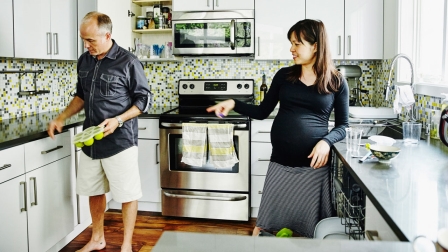A Practical Guide For Working Parents To Divide Household Responsibilities
Whose job is it to sign the kids up for summer camp, fill out (and fax) the tedious forms, make sure that peanut-free lunches are packed every evening, and drive children to their fun-filled destinations each day?
In many households—even in this age of egalitarian marriages and dual-income households—much of this minutiae of parenting falls to mom.
And it’s burning women out, both at home and at the office. What’s causing this gulf in responsibility, and what’s a modern couple to do? The first important step is to acknowledge that there’s a problem.
Inequality Starts With Parental Leave
Many couples happily sail along as equals before they have their first child, dividing jobs at home, charging ahead at the office, and dreaming of the family they’ll create together. Today, millennial women are more highly educated than their male counterparts; Millennial men, when surveyed, say that they want to be much more involved as parents than previous generations of fathers.
But the reality of pregnancy and the disparity in maternity and paternity leave policies (women often get some paid or unpaid time off—men infrequently do), means that women take on the brunt of work with a newborn. As they develop a speciality caring for their children, the divide in parental confidence between men and women begins. Within weeks, a new mom knows how to tell the difference between baby’s hunger cries and sleepy cries; dad, with fewer hours on the job, looks to his partner to guide him.
Mom develops competence in her skills as a parent, dad often develops a deference to her. So what might begin as a small divide when baby is born starts to multiply during maternity leave, and grows larger still when you consider our cultural expectations of men’s and women’s roles at home.
Start Crediting The Thinking Work
Many women do much of the mental work of taking care of children, which can often go unnoticed. This so-called “psychic burden” of motherhood—making sure that all the small things get done—is real, and it can be draining for women, especially when it doesn’t have tangible results. Being a master arranger of a toddler’s play dates doesn’t seem to resonate on LinkedIn.
Couples can start to address this “thinking” divide by making a list of all the work and responsibilities that go into your family life. Start by going through this household responsibilities worksheet.
Often one partner doesn’t realize how much extra work the other is taking on—if mom is picking up the slack at home, perhaps dad feels pressure to dig in deeper at the office.
Bringing each party’s burdens to a calm, objective conversation can help reduce tension at home. Going line-by-line on items that need to be completed helps get everyone on the same page—and gives you a roadmap for how to make changes.
Divide Responsibilities Not Tasks
One way to rethink household duties is by dividing them by responsibility rather than task. This allows each person to bucket tasks that encompass the thinking work, and to allow partners to gain confidence to manage it on their own.
For example, perhaps one person can manage all family health care issues. That means one party is responsible for finding doctors, arranging appointments, submitting reimbursements, paying medical bills—and filling out those camp forms. Making sure that entire categories of responsibility are “owned” by a single person helps prevent mission creep.
Plus, when you own a whole area of responsibility, you develop domain expertise in it. This allows each party to develop a greater sense of appreciation for how much thought and effort goes into managing a particular project, and makes it more efficient and less of a source of friction.
Trade Places
Once the household responsibilities are divided, couples should also occasionally take turns trading jobs so each person understands how much work goes into it.
Cooking dinner for the family involves a lot of prep time, mental math, psychological warfare (yes, you must eat your vegetables), and cleanup. But if your partner is the one doing it every night, you might not appreciate how much thought and energy goes into it—until it’s your turn to try to get the kids to eat a single meal not made of macaroni and cheese.
Trading places can build a sense of empathy and understanding for your partner—all good things to invest in at home.
Let It Go
If women are often responsible for managing household minutiae, then they might need to find ways to let it go.
You might need to let go a need to coach your partner through tasks, like cooking dinner, but first you may need to impart that expertise over. In our household, one Christmas I had magnets made of our regular family recipes that we make—so our my husband doesn’t have to ask me how much chicken stock goes into the risotto each and every time he makes it.
And once you hand responsibility over, you might just need to let control go, too. Sheryl Sandberg recommends that women:
“Let [their husbands] put the diaper on the baby anyway he wants to as long as he’s doing it himself. And if he gets up to deal with the diaper before being asked, she should smile even if he puts that diaper on the baby’s head.”
Another option for couples looking to divide household responsibilities is to figure out which tasks they can give up to a professional. Investing in a weekly housecleaner to manage the laundry can free up hours each week for families. Getting some extra childcare help on weekends can help couples to complete errands quickly while kids are being entertained—opening more hours up for quality family time.
Work With A Professional
Couples counseling isn’t just for couples whose marriages are in trouble. If you reframe working with a couples counselor as an investment in your marriage, rather than a “fix” for something that’s broken, you can come out with stronger communication skills, more empathy for your partner, and a better understanding of each of your individual needs.
Renegotiate. Again
What works in terms of dividing household responsibilities during maternity leave might not work after mom goes back to work. And what works during a particular season of life might not work if one person gains a more flexible position at work.
Couples should continue to evaluate household responsibilities together as life responsibilities change. Checking in at the birth of a baby, after maternity leave, when a new child arrives, or when job roles change, are all great opportunities to reevaluate who does what at home and work.
Allyson Downey is the founder of weeSpring.com and the author of Here’s the Plan: Your Practical, Tactical Guide to Advancing Your Career During Pregnancy and Parenthood. To learn more strategies for excelling in your professional life while raising a family, check out her Mother.ly course, “Work It: Your Inspired Guide to Rock Working Motherhood.”
Fast Company , Read Full Story
(31)













